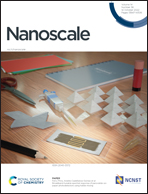Redox-switchable host–guest complexes of metallocenes and [8]cycloparaphenylene†
Abstract
The cycloparaphenylene (CPP) nanocarbons are an appealing family of macrocyclic organic semiconductors with size-tunable structures and unique optoelectronic properties, which can be further modulated by complexation with guest molecules. While many π–π-stabilized CPP-fullerene host–guest complexes are known, CPPs can also host polycyclic guests stabilized by aromatic CH–π interactions. Here we combine experimental and computational results to report that CH–π interactions can also be tapped to include redox-active metallocene guests in [8]cycloparaphenylene ([8]CPP). Oxidation of a metallocene guest is accompanied by an increase in binding affinity and tilt angle. Crystallographically determined solid-state structures reveal CH–π interactions in the ferrocene complex (Fc⊂[8]CPP) and additional π–π interactions in the cobaltocenium complex (CoCp2+⊂[8]CPP). Functionalizing Fc with oxygen-bearing side chains also improves complex stability to a similar extent as oxidation, due to the formation of CH–O hydrogen bonds with the host's p-phenylene units. This work shows that CH–π bonding can be generalized as a driving force for CPP host–guest complexes and combined with other supramolecular forces to enhance stability. Owing to their semiconducting nature, amenability to functionalization, and reversible redox-dependent behavior, the [8]CPP-metallocene host–guest complexes may expand the library of synthons available for designing bespoke nanoelectronics and artificial molecular machines.
![Graphical abstract: Redox-switchable host–guest complexes of metallocenes and [8]cycloparaphenylene](/en/Image/Get?imageInfo.ImageType=GA&imageInfo.ImageIdentifier.ManuscriptID=D2NR03852H&imageInfo.ImageIdentifier.Year=2022)


 Please wait while we load your content...
Please wait while we load your content...
